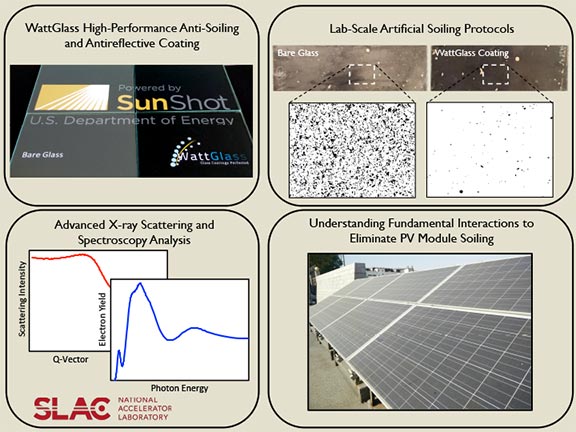Advanced Multifunctional Coatings for PV Glass to Reduce Soiling and PID Losses
As a DuraMAT project, WattGlass is conducting a fundamental investigation into the physical and chemical interactions that occur between environmental soils and anti-soiling (AS)/anti-reflective (AR) coatings for photovoltaic (PV) glass. It's using its own AS/AR coating as the pilot material.
The investigation will result in a testing protocol that can be applied to an arbitrary AS/AR coating. It will also facilitate the further development of coatings with novel anti-soiling chemistries.
In addition, WattGlass is evaluating a novel double-sided coating for solar glass to reduce potential induced degradation (PID) losses in high-voltage PV module architectures.
For the project, WattGlass is utilizing advanced X-ray scattering and spectroscopy tools at SLAC National Accelerator Laboratory, as well as the artificial soiling methodologies developed at Sandia National Laboratories (SNL).
Transmittance losses due to soiling of PV modules have a large, negative impact on the levelized cost of electricity. In some geographic regions, the combined effect of soiling losses can result in the reduction of module efficiency and power output in excess of 30%. This has led to much interest in development of AS/AR coatings. However, relatively little is understood about the fundamental mechanisms that contribute to the anti-soiling properties of AS/AR coatings.
Core Objective
Location
WattGlass, Inc., in collaboration with SLAC and SNL
Applications
Knowledge of the physical chemical interactions that occur between AS/AR coatings and environmental soils will:
- Drive the adoption of AS/AR coatings in the solar industry
- Help identify geographic regions where specific coating chemistries are optimum
- Lead to new material designs.
Availability
Available to collaborators at national labs and industry.
References
Moffitt, S.L., Riley, C., Ellis, B.H., Fleming, R.A., Thompson, C.S., Burton, P.D., Gordon, M.E., Zakutayev, A., and Schelhas, L.T., 2020, “Combined Spatially Resolved Characterization of Antireflection and Antisoiling Coatings for PV Module Glass,”ACS Combinatorial Science, 22, 4, 197-203.
Moffitt, S.L., Fleming, R.A., Thompson, C.S., Titus, C.J., Kim, E., Leu, L., Toney, M.F., and Schelhas, L.T., 2019, “Advanced X-ray Scattering and Spectroscopy Characterization of an Antisoiling Coating for Solar Module Glass,”ACS Applied Energy Materials, 2, 11, 7870-7878.
Fleming, R.A., Sahm, A., Sherwin, J.R., King, B.H., and Thompson, C.S., “Field Installations of a High-Performance Antireflective Coating for Solar Modules,”2019 NREL Photovoltaic Reliability Workshop, Golden, CO, February 26-28, 2019.
Moffitt, S.L., Fleming, R.A., Thompson, C.S., Toney, M.F., and Schelhas, L.T., “Fundamental Characterization of Anti-Soiling Coatings for PV Glass: Application of Small-Angle X-ray Scattering,” 2018 IEEE PVSC, Waikoloa, HI, June 10-15, 2018.
Fleming, R.A., Pop, S.C., Moffitt, S.L., Schelhas, L.T., and Thompson, C.S., “Advanced Multifunctional Coatings for PV Glass to Reduce Soiling and PID Losses,” 2018 NREL Photovoltaic Reliability Workshop, Golden, CO, February 27 –March 1, 2018.
Freiburger, B., Thompson, C.S., Fleming, R.A., Hutchings, D., and Pop, S.C., “High Efficiency Anti-Reflective Coating for PV Module Glass,” 2017 IEEE PVSC, Washington, D.C., June 25-30, 2017.
Contact
To learn more about this project, contact Drew Fleming or Corey Thompson.
